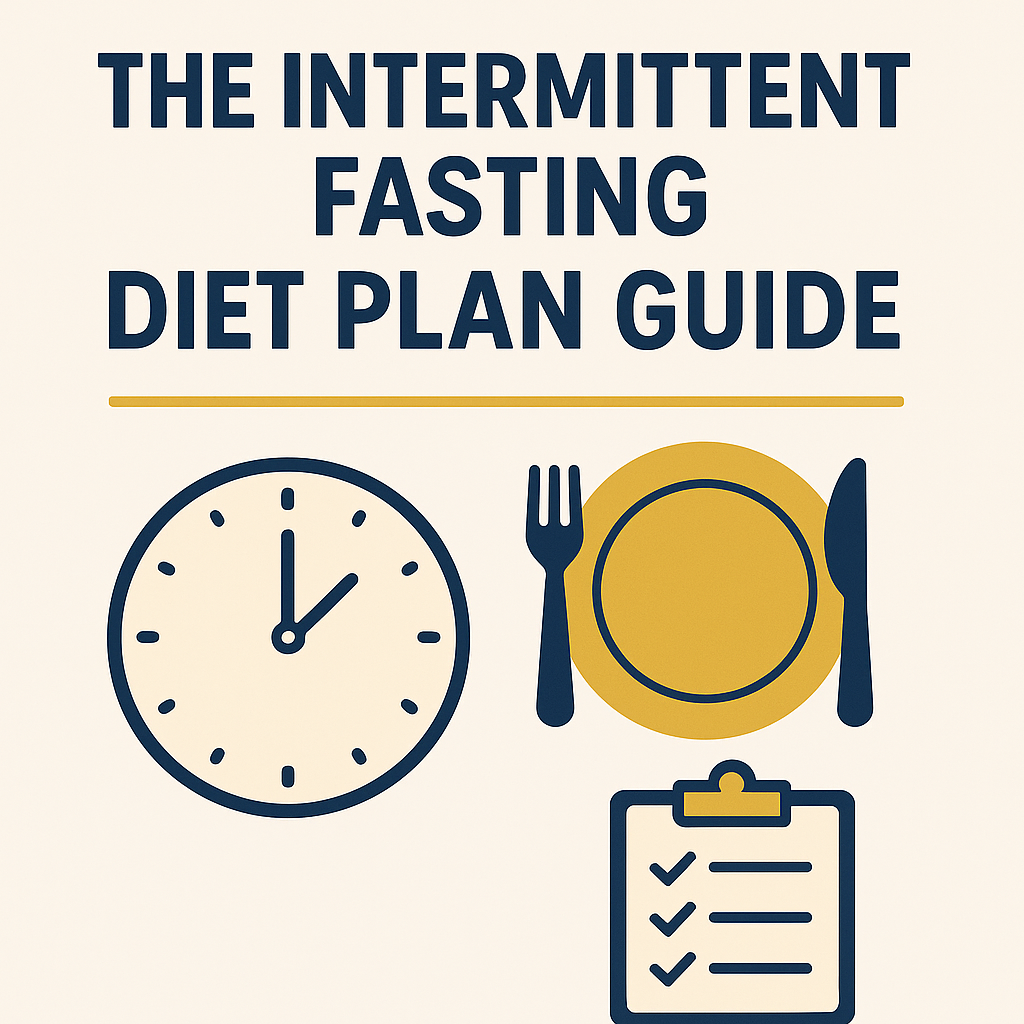The Intermittent Fasting Diet Plan Guide: Proven Strategies & Benefits in 2025
The Intermittent Fasting Diet Plan Guide reveals top strategies, health benefits, and beginner-friendly tips to help you lose weight, boost metabolism, and improve overall health.
What Is Intermittent Fasting?
Understanding the Basics
Intermittent fasting (IF) is not a traditional diet. Instead of focusing on what you eat, it focuses on when you eat. It alternates between periods of eating and fasting, helping your body utilize stored energy and reduce overall calorie intake. While some view it as a weight-loss tool, many appreciate it for its metabolic and cognitive benefits.
Historical and Cultural Context
Fasting is deeply rooted in human culture and evolution. Ancient humans often went hours or even days without food due to scarcity. Religions such as Islam, Christianity, and Buddhism have practiced fasting for spiritual growth. Today, science backs many of these time-tested traditions.
Types of Intermittent Fasting Plans
16:8 Method
This is the most popular and beginner-friendly method. You fast for 16 hours and eat within an 8-hour window. For example, you might eat from 12 p.m. to 8 p.m. and fast the rest of the time.
5:2 Method
Eat normally for five days of the week, and on two non-consecutive days, limit intake to 500–600 calories. This method suits those who prefer structure but dislike daily fasting.
Alternate-Day Fasting
As the name implies, you alternate between a day of normal eating and a day of fasting or significantly reduced calorie intake. It can be more challenging but offers quick results.
OMAD (One Meal a Day)
This extreme version limits intake to one big meal per day. It’s effective for weight loss but may not suit everyone due to its intensity.
Warrior Diet
Eat small amounts of raw fruits and vegetables during the day and one large meal at night, typically within a 4-hour window. It’s inspired by ancient warrior eating patterns.
How Intermittent Fasting Works in the Body
Insulin and Blood Sugar Regulation
Fasting lowers insulin levels, allowing your body to tap into fat stores for energy. Lower insulin also stabilizes blood sugar, reducing the risk of type 2 diabetes.
Ketosis and Fat-Burning Mechanisms
Prolonged fasting pushes the body into ketosis, a state where fat becomes the primary fuel source. This accelerates fat loss without muscle depletion.
Cellular Repair and Autophagy
Autophagy, triggered by fasting, is the process by which cells clean out damaged components. This promotes longevity and may reduce the risk of diseases like cancer and Alzheimer’s.
Health Benefits of Intermittent Fasting
Weight Loss and Fat Reduction
By reducing the eating window, most people naturally consume fewer calories. This, combined with hormonal shifts, promotes efficient fat burning and weight reduction.
Improved Metabolic Health
Intermittent fasting improves insulin sensitivity, cholesterol levels, and blood pressure—all crucial indicators of metabolic health.
Mental Clarity and Brain Health
Fasting increases brain-derived neurotrophic factor (BDNF), which supports brain function and reduces the risk of neurodegenerative diseases.
Longevity and Disease Prevention
Animal studies show that intermittent fasting may extend lifespan and prevent age-related diseases by promoting cellular repair and reducing inflammation.
Getting Started with an Intermittent Fasting Diet Plan
Choosing the Right Fasting Method
Beginners should start with the 16:8 method for ease and flexibility. As your body adapts, you can experiment with other formats to see what fits best.
Setting Realistic Goals
Rather than aiming for rapid weight loss, focus on sustainable habits. Set goals like increasing fasting hours gradually or improving energy levels.
Creating a Sample Weekly Plan
| Day | Eating Window | Notes |
| Monday | 12:00 pm – 8:00 pm | Start week strong with hydration |
| Tuesday | 1:00 pm – 9:00 pm | Shift window slightly |
| Wednesday | Fasting Day (if 5:2) | Light activity only |
| Thursday | 12:00 pm – 8:00 pm | Include lean protein and fiber |
| Friday | 1:00 pm – 9:00 pm | Adjust based on hunger cues |
| Saturday | Flexible | Social eating allowed |
| Sunday | Rest day or fasting | Reflect and plan ahead |
What to Eat During Eating Windows
Nutrient-Dense Foods to Prioritize
- Leafy greens
- Lean proteins (chicken, eggs, tofu)
- Healthy fats (avocado, olive oil, nuts)
- Whole grains (quinoa, oats)
- Low-glycemic fruits (berries, apples)
Sample Meal Ideas for Fasters
- Lunch: Grilled chicken salad with olive oil dressing
- Snack: Greek yogurt with berries
- Dinner: Baked salmon, quinoa, steamed broccoli
Foods and Drinks to Avoid
- Sugary snacks and drinks
- Highly processed foods
- Excess caffeine during fasting hours
- Alcohol (can disrupt fasting benefits)
Common Mistakes and How to Avoid Them
Overeating During Feeding Time
It’s tempting to binge after fasting, but that undermines the process. Eat slowly and focus on balanced meals.
Ignoring Hydration
Water, herbal teas, and black coffee are crucial. Staying hydrated helps reduce headaches and fatigue during fasting.
Expecting Quick Results
Fasting is a lifestyle, not a magic bullet. Weight loss and other benefits may take several weeks to appear consistently.
Intermittent Fasting for Different Lifestyles
For Busy Professionals
A 16:8 schedule fits well with work routines—skip breakfast, have lunch and dinner.
For Athletes and Active Individuals
Time your workouts before your eating window to fuel recovery. Protein shakes can be taken post-workout during the eating period.
For Stay-at-Home Parents
Flexible fasting plans, like 12:12 or 14:10, help balance family meals and responsibilities.
Safety Tips and Medical Considerations
Who Should Avoid Intermittent Fasting
- Pregnant or breastfeeding women
- Individuals with eating disorders
- People on medications for diabetes or blood pressure without doctor supervision
Consulting with a Healthcare Provider
Before starting, it’s best to consult a doctor—especially if you have pre-existing health conditions or are taking medication.
Tracking Progress and Staying Motivated
Using Journals and Apps
Apps like Zero, Fastic, and Life help track fasting hours, meals, and mood patterns. Journaling increases mindfulness and accountability.
Measuring Results Beyond the Scale
Monitor your energy levels, sleep quality, mental clarity, and mood. These are signs of success beyond weight loss.
Combining Intermittent Fasting with Other Diets
Keto and Low-Carb Pairing
IF enhances the effects of keto by accelerating ketosis, making fat burning more efficient.
Paleo and Whole30 Compatibility
Whole foods complement fasting by reducing blood sugar spikes and promoting sustained energy.
Frequently Asked Questions (FAQs)
Can I drink coffee while fasting?
Yes, black coffee is allowed and may even suppress appetite. Avoid cream or sugar as they break the fast.
Will intermittent fasting slow down my metabolism?
No, when done properly, IF can actually enhance metabolic rate in the short term.
How long before I see results?
Many notice changes in 2–4 weeks, though it varies by individual.
Can I work out while fasting?
Yes, but start slow. Fasted cardio can be effective, but intense workouts may require pre-fueling.
Is intermittent fasting safe for women?
Yes, but women should start with shorter fasts (e.g., 12–14 hours) and adjust based on how their body responds.
What breaks a fast?
Calories from any source, especially sugars and fats, break a fast. Water, black coffee, and herbal tea are safe.
Conclusion: Is Intermittent Fasting Right for You?
Intermittent fasting is a flexible, powerful approach to better health, weight management, and mental clarity. Whether you’re looking to shed pounds, boost metabolism, or gain control over eating habits, IF can fit into nearly any lifestyle. Start slow, stay consistent, and listen to your body. With time and dedication, the results will speak for themselves.
Types of Diets: A Step-by-Step Guide
Carb Cycling to Burn Fat and Maintain Muscle – A Proven Strategy
Gain Muscle And Burn Fat Theory
Follow Us On




